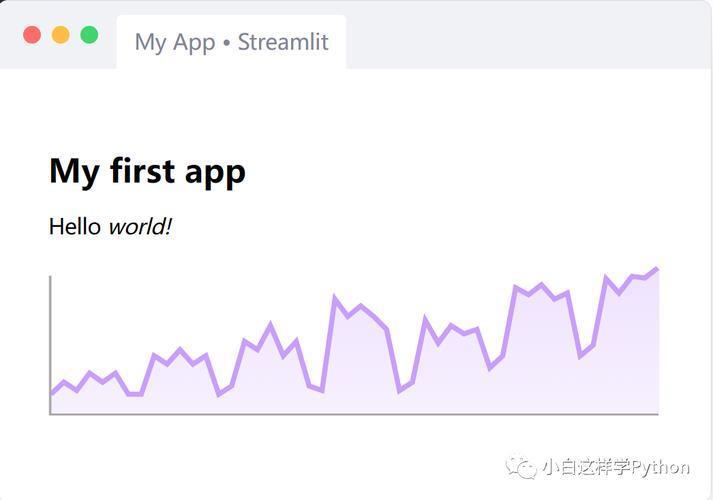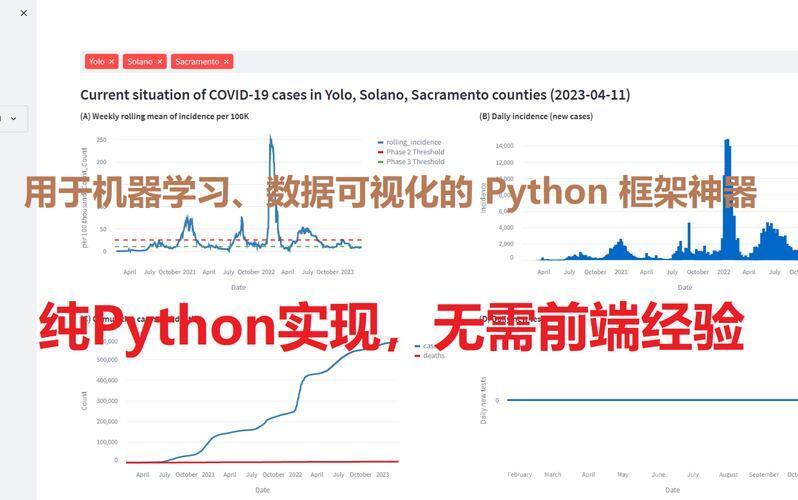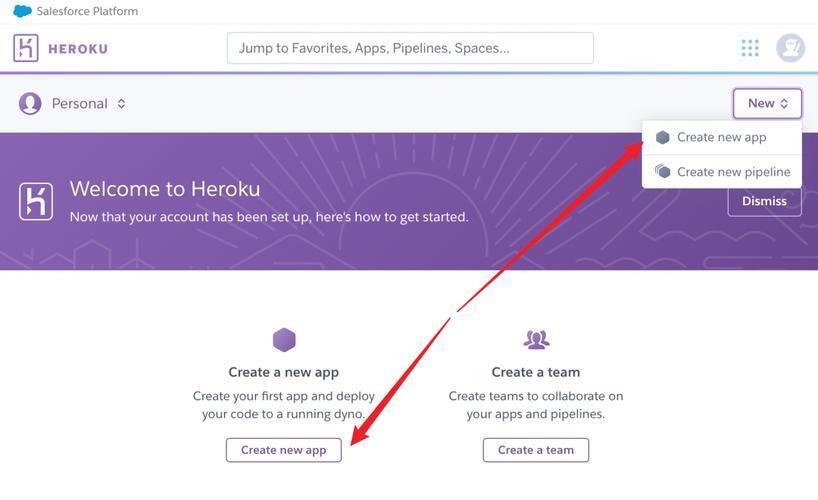【Python】Streamlit 库:快速构建交互式 Web 应用程序
Streamlit 是一个开源的 Python 库,用于快速构建交互式 Web 应用程序,特别适合数据科学家和机器学习工程师。它以简单直观的 API 著称,允许用户通过纯 Python 代码创建数据可视化、仪表板和交互式工具,无需前端开发经验。Streamlit 应用程序可以通过浏览器访问,支持实时更新和用户交互,广泛用于数据探索、模型展示和快速原型开发。
以下是对 Streamlit 库的详细介绍,包括其功能、用法和实际应用。
1. Streamlit 库的作用
- 快速开发:通过简单的 Python 脚本创建 Web 应用,无需 HTML/CSS/JavaScript 知识。
- 交互性:支持输入控件(如滑块、下拉菜单、文本框)实现用户交互。
- 数据可视化:无缝集成常见可视化库(如 Matplotlib、Plotly、Altair)。
- 实时更新:代码修改后自动刷新页面,加速开发迭代。
- 部署简单:支持本地运行和云部署(如 Streamlit Community Cloud、Heroku、AWS)。
2. 安装与环境要求
- Python 版本:支持 Python 3.8+(推荐 3.9+)。
- 依赖:
- pandas:数据处理。
- numpy:数值计算。
- tornado:Web 服务器。
- 可选:可视化库(如 matplotlib、plotly)。
- 安装命令:
pip install streamlit
- 验证安装:
streamlit hello
- 运行后,浏览器会打开 Streamlit 的欢迎页面(默认 http://localhost:8501)。
- 运行 Streamlit 应用:
streamlit run app.py
- app.py 是包含 Streamlit 代码的 Python 文件。
3. 核心功能与用法
Streamlit 的核心是通过 st 模块提供的函数(如 st.write、st.button)构建应用界面。以下是主要功能和示例。
3.1 显示文本和数据
使用 st.write、st.title 等显示内容。
import streamlit as st st.title("My First Streamlit App") st.write("Welcome to Streamlit!") st.markdown("This is **bold** text with *italics*.")说明:
- st.title:设置页面标题。
- st.write:通用输出,支持文本、数据框、图表等。
- st.markdown:渲染 Markdown 格式文本。
3.2 交互控件
支持多种输入控件,实现用户交互。
import streamlit as st # 文本输入 name = st.text_input("Enter your name", "John Doe") st.write(f"Hello, {name}!") # 滑块 age = st.slider("Select your age", min_value=0, max_value=100, value=25) st.write(f"You are {age} years old.") # 下拉菜单 option = st.selectbox("Choose a color", ["Red", "Blue", "Green"]) st.write(f"Selected color: {option}") # 按钮 if st.button("Click me"): st.write("Button clicked!")说明:
- 控件的值存储在变量(如 name、age),可用于动态更新。
- Streamlit 自动重新运行脚本以反映用户输入。
3.3 数据可视化
集成 Pandas、Matplotlib、Plotly 等库展示数据。
import streamlit as st import pandas as pd import plotly.express as px # 显示数据框 df = pd.DataFrame({ "x": [1, 2, 3, 4], "y": [10, 20, 25, 30] }) st.dataframe(df) # 绘制图表 fig = px.line(df, x="x", y="y", title="Simple Line Chart") st.plotly_chart(fig)说明:
- st.dataframe:显示交互式数据表。
- st.plotly_chart:渲染 Plotly 图表(支持 matplotlib、altair 等)。
3.4 文件上传
处理用户上传的文件(如 CSV、图片)。
import streamlit as st import pandas as pd uploaded_file = st.file_uploader("Upload a CSV file", type=["csv"]) if uploaded_file is not None: df = pd.read_csv(uploaded_file) st.write("Uploaded Data:") st.dataframe(df)说明:
- st.file_uploader:支持指定文件类型。
- 上传文件后可直接处理(如用 Pandas 解析)。
3.5 缓存数据
使用 @st.cache_data 缓存昂贵计算,提高性能。
import streamlit as st import pandas as pd @st.cache_data def load_data(): # 模拟昂贵操作 return pd.DataFrame({"col1": range(1000), "col2": range(1000, 2000)}) df = load_data() st.write("Cached Data:", df.head())说明:
- @st.cache_data 缓存函数结果,避免重复计算。
- 适合加载大文件或复杂计算。
3.6 布局与容器
使用 st.columns、st.sidebar 组织界面。
import streamlit as st # 侧边栏 st.sidebar.title("Settings") option = st.sidebar.selectbox("Mode", ["Light", "Dark"]) # 列布局 col1, col2 = st.columns(2) with col1: st.write("Column 1 content") with col2: st.write("Column 2 content")说明:
(图片来源网络,侵删)- st.sidebar:将控件放入侧边栏。
- st.columns:创建多列布局。
4. 性能与特点
- 高效开发:几行代码即可创建交互式应用。
- 实时更新:修改代码后页面自动刷新。
- 内存效率:支持缓存机制,优化大数据处理。
- 局限性:
- 不适合复杂前端逻辑(如动态 JavaScript)。
- 单线程运行,可能不适合高并发场景。
- 扩展性:通过 streamlit.components 支持自定义 HTML/JavaScript。
5. 实际应用场景
- 数据仪表板:展示数据分析结果(如销售数据、实验结果)。
- 机器学习演示:展示模型预测和可视化(如分类器、回归)。
- 交互工具:构建数据查询或过滤工具。
- 教育应用:创建交互式教学工具(如数学计算器)。
- 快速原型:验证数据产品或应用概念。
示例(交互式数据分析):
import streamlit as st import pandas as pd import plotly.express as px st.title("Data Analysis Dashboard") # 文件上传 uploaded_file = st.file_uploader("Upload CSV", type=["csv"]) if uploaded_file: df = pd.read_csv(uploaded_file) st.dataframe(df.head()) # 列选择 column = st.selectbox("Select column to plot", df.columns) fig = px.histogram(df, x=column) st.plotly_chart(fig) # 过滤数据 threshold = st.slider("Filter threshold", float(df[column].min()), float(df[column].max())) filtered_df = df[df[column] > threshold] st.write("Filtered Data:", filtered_df)说明:
(图片来源网络,侵删)- 用户上传 CSV,查看数据并绘制直方图。
- 滑块过滤数据,实时更新显示。
6. 部署
Streamlit 应用可以本地运行或部署到云端。
- 本地运行:
streamlit run app.py
- Streamlit Community Cloud(推荐):
- 将代码推送到 GitHub 仓库。
- 登录 Streamlit Community Cloud(https://share.streamlit.io/)。
- 连接 GitHub 仓库,配置 app.py 和 requirements.txt。
- 部署后获取公共 URL。
- 其他平台:
- Heroku:使用 Dockerfile 或 Procfile。
- AWS EC2:运行 Streamlit 服务器。
- Docker:
FROM python:3.9 WORKDIR /app COPY . . RUN pip install -r requirements.txt CMD ["streamlit", "run", "app.py", "--server.port=8501"]
7. 注意事项
- 性能:
- 大型数据集可能导致页面卡顿,使用 @st.cache_data 优化。
- 避免在循环中频繁调用 st 函数。
- 交互限制:
- 每次用户交互触发脚本重新运行,需注意状态管理(使用 st.session_state)。
if "count" not in st.session_state: st.session_state.count = 0 if st.button("Increment"): st.session_state.count += 1 st.write("Count:", st.session_state.count) - 兼容性:
- 确保可视化库(如 Plotly)版本与 Streamlit 兼容。
- 最新版本(截至 2025,1.39.0)支持更多功能。
- 安全性:
- 云部署时,使用环境变量存储敏感信息:
import os api_key = os.getenv("API_KEY") - 局限性:
- 不支持复杂前端交互(如实时 WebSocket)。
- 高并发需结合 WSGI 服务器(如 Gunicorn)。
8. 综合示例
以下是一个综合示例,展示数据上传、可视化和交互过滤:
(图片来源网络,侵删)import streamlit as st import pandas as pd import plotly.express as px st.title("Interactive Data Explorer") # 侧边栏设置 st.sidebar.header("Options") chart_type = st.sidebar.selectbox("Chart Type", ["Line", "Scatter", "Histogram"]) # 文件上传 uploaded_file = st.file_uploader("Upload a CSV file", type=["csv"]) if uploaded_file: @st.cache_data def load_data(): return pd.read_csv(uploaded_file) df = load_data() st.write("Data Preview:", df.head()) # 选择列 columns = df.columns.tolist() x_col = st.selectbox("X-axis", columns) y_col = st.selectbox("Y-axis", columns) # 绘制图表 if chart_type == "Line": fig = px.line(df, x=x_col, y=y_col) elif chart_type == "Scatter": fig = px.scatter(df, x=x_col, y=y_col) else: fig = px.histogram(df, x=x_col) st.plotly_chart(fig) # 数据过滤 if st.checkbox("Filter Data"): threshold = st.slider(f"Filter {y_col} >", float(df[y_col].min()), float(df[y_col].max())) filtered_df = df[df[y_col] > threshold] st.write("Filtered Data:", filtered_df)说明:
- 用户上传 CSV,选择图表类型和坐标轴。
- 支持动态过滤数据并实时更新图表。
9. 资源与文档
- 官方文档:https://docs.streamlit.io/
- GitHub 仓库:https://github.com/streamlit/streamlit
- PyPI 页面:https://pypi.org/project/streamlit/
- 社区论坛:https://discuss.streamlit.io/
- 教程:
- Streamlit 官方教程:https://docs.streamlit.io/library/get-started
- DataCamp Streamlit 指南:https://www.datacamp.com/tutorial/streamlit
- 云部署时,使用环境变量存储敏感信息:
- 每次用户交互触发脚本重新运行,需注意状态管理(使用 st.session_state)。
- 性能:
- 本地运行:
- app.py 是包含 Streamlit 代码的 Python 文件。
免责声明:我们致力于保护作者版权,注重分享,被刊用文章因无法核实真实出处,未能及时与作者取得联系,或有版权异议的,请联系管理员,我们会立即处理! 部分文章是来自自研大数据AI进行生成,内容摘自(百度百科,百度知道,头条百科,中国民法典,刑法,牛津词典,新华词典,汉语词典,国家院校,科普平台)等数据,内容仅供学习参考,不准确地方联系删除处理! 图片声明:本站部分配图来自人工智能系统AI生成,觅知网授权图片,PxHere摄影无版权图库和百度,360,搜狗等多加搜索引擎自动关键词搜索配图,如有侵权的图片,请第一时间联系我们。







